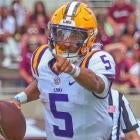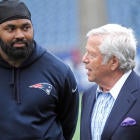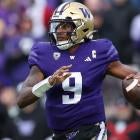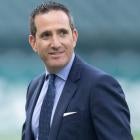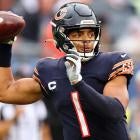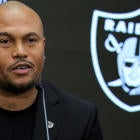The NFL is an ever-evolving game, which means that its teams have to be ready to adapt with the times if they want to compete. When it comes to the NFL, a league with a steep learning curve and one intentionally marred with parity, the task of adapting on the fly to achieve the ultimate goal is that much more daunting. Few teams understand the challenge of returning to a Super Bowl like the San Francisco 49ers, who fought their way to the Big Game seven years ago only to fall short against the Baltimore Ravens, and will now face off against the Kansas City Chiefs on Feb. 3 in Miami for all the marbles.
Before the clash with the Ravens in yesteryear, they hadn't been since the mid-1990s, and that's evidence that unless you're the New England Patriots under Bill Belichick -- who themselves were eliminated in this year's wild card -- you have to turbo through the exceedingly small window of opportunity when you get the chance. Now having dismissed the Green Bay Packers in their first NFC title bout in six seasons, a lot had to go right for the 49ers to get to where they are today.
That included being able to gut through the things that went wrong to remain one of the best teams in the entire NFL.
So, how'd they do it? It was a mostly magical season, yes, but was there a quick fix? One single acquisition that suddenly turned them from a 4-12 club to one that went on a tear in 2019 before finishing with a 13-3 record? The answer is a resounding "no", and it's time to review the proof of just how much risk they took to get to this point because that's truly the only way anyone can appreciate what the 49ers are showing us in 2019.
You don't have to like them. You can even loathe them if that's your preference, but football law dictates we all put some respec[k] on their name.
That's law.
A new chief of police - General manager
The 49ers hadn't had a winning season since 2013, and team CEO Jed York had seen enough. York decided to blow up the team in 2017, but he wasn't looking for retreads in his new leadership. His first big risk was naming John Lynch general manager, a former nine-time Pro Bowl safety with no experience running an NFL team. York was laughed at by some and written off as crazy by others, but it turned out he knew exactly what he was doing when he rolled those dice. Lynch engineered a fairly rapid turnaround and one that can only truly be appreciated by dissecting what's occurred since he took the reins.
One of the most talented executives in the league, he is outperforming general managers and other front office personnel from around the league who have a decade's more experience than he does, and at the tender age of 48 -- no less.
Young, talented watch commander - Head coach
Arguably the best decision York made was giving the green light to Lynch to bring in Kyle Shanahan as the new head coach in 2017 after a disastrous one-year experiment with Chip Kelly that followed an unproductive one-year stint under former defensive line coach Jim Tomsula -- the two coaches combining for an abysmal 7-28 record in two seasons following the decision to move on from Jim Harbaugh. With the emergence of Sean McVay in Los Angeles, the 49ers wanted to find a young, creative leader of their own.
Enter Shanahan, an offensive coordinator who led the Atlanta Falcons to a Super Bowl only two seasons prior. Things didn't end well in that game after the Falcons took an infamous 28-3 lead before ultimately losing to the Patriots, but Shanahan took the lessons learned with him to Santa Clara. Nearly the same age as York when he got the job, it was clear the 49ers weren't afraid of risk, but the next task was as important as the previous ones: determining who'd be the franchise quarterback.
Lynch and Shanahan already had someone in mind, and it wasn't Colin Kaepernick.
Trade for the big gun - Quarterback
Kaepernick had already begun to wear out his welcome by the time 2017 rolled around, and I'm not talking about his silent civil rights protests during the national anthem -- although many would argue that played a part. On the field, he couldn't regain the magic he had when he took over for Alex Smith and led the 49ers to the Super Bowl, and Shanahan had other ideas for the offense that didn't fit Kaepernick's skill set. The friction between Kaepernick and the club led to his release and the decision to trade with the Patriots and land backup Jimmy Garoppolo in exchange for a 2018 second-round pick.
In 2018, with less than a handful of starts under his belt for the 49ers, the two sides agreed on a five-year, $137 million extension; and that served notice Garoppolo would be the QB of the future in San Francisco. Things weren't all roses from the outset, however, with the young QB suffering a torn ACL that cost him 13 games that season, and his preseason return in 2019 was inconsistent at best, leading some to begin to consider his trade value and/or cap savings if released.
Instead, Garoppolo took that leap forward, throwing for a career-best 3,978 passing yards with 27 touchdowns to only 13 interceptions, serving up a huge platter of crow to his doubters in the process. Some of those doubters were the Saints, but um, well, you know -- 349 yards with four touchdowns and a win tend to disagree.
Emmanuel Sanders reels in the deep pass from Jimmy Garoppolo, falls over, gets up and outruns the Saints defense for the score. #49erd
— Rob Lowder (@Rob_Lowder) December 8, 2019
(🎥: @49ers)pic.twitter.com/0gWFxaQLC1
Set up a task force - Running backs
By now you're gathering just how much the 49ers do not care about conventional thought, and if you still haven't grasped it, take a look at what they installed behind Garoppolo. While most NFL teams are either looking for a bell-cow running back or a one-two punch tandem who complement each other in skill set, Lynch and Shanahan opted to go with a three-headed beast that made it difficult to game plan for. After all, if an opposing defensive coordinator cut off one of Ghidorah's heads, there were still two remaining; and if you were good enough to lop off two, well, still one remained.
The names of the kaiju's heads are Raheem Mostert, Matt Breida, Tevin Coleman, with the latter having spent time in Atlanta with Shanahan. The three halfbacks can do damage on the ground and in the air, and combined for a massive 1,939 rushing yards -- despite injury -- to go along with 15 rushing touchdowns. All told, they produced 2,419 yards from scrimmage and 20 touchdowns total, and those are numbers that helped keep the heat off of Garoppolo, with opposing pass rushers having to account for the 49ers rushing attack.
Oh, and none of them were drafted by the 49ers. Mostert was a journeyman who worked his way up from the practice squad, Coleman hailed from Atlanta and Breida was an undrafted free agent of the 49ers in 2017. And those who labeled Mostert a throwaway before he took a single snap this season have a stomach full of crow after seeing him set an NFL rushing record against the Packers to power the Niners to the Super Bowl.
Talent evaluation grade: A+
Raheem Mostert.
— San Francisco 49ers (@49ers) January 20, 2020
That's it. That's the tweet.#BeLegendary pic.twitter.com/xirNLEvbBF
Establish the riot line - Offensive line
Garoppolo and the aforementioned three-headed feaster of men's souls can only be as good as the big bodies tasked with playing in front of them, and with veteran Joe Staley serving as longtime anchor at left tackle, the 49ers went all-in on securing protection at the right edge by drafting Mike McGlinchey in the first round of the 2018 NFL Draft. McGlinchey was almost immediately named starting right tackle in his rookie season, and the team never wavered as he fought through early growing pains at the NFL level.
The decision to then sign Ben Garland in 2019 out of free agency -- having also spent time with Shanahan in Atlanta -- to secure the center position was a good call, and one year prior they locked up Laken Tomlinson on a three-year deal after landing him from the Detroit Lions in 2017 in exchange for a fifth-round pick in 2019.
The decision to sign Garland may be the most underrated acquisition that led the 49ers to where they are. Prior to signing Garland, they signed former Giants second-round center Weston Richburg to a lucrative multi-year contract. During the 2019 season, Richburg returned to a near All-Pro level, but he suffered a season-ending injury in the second half. Garland stepped right in and the 49ers didn't skip a beat. Most teams wouldn't be prepared for a season-ending injury at the pivot position on the offensive line, but the 49ers were.
Unlike a team like the Dallas Cowboys, who invested multiple first-round picks in their offensive line, the 49ers piecemealed theirs together. This is far from a knock against the Cowboys, given the fact they might have three future Hall of Famers on their offensive line, but instead, it's a huge kudos to Shanahan for being able to coach up his band of men and Lynch for making the deals happen -- one that includes a stalwart 49ers left tackle, a young first-round pick and some free agent pieces meshed together with an impressive recipe.
It doesn't have to work for 10 years. It just has to work right now, and it is.
The Lone Ranger, at the ready - Tight End
George Kittle. That's it. That's the analysis.
Leading the team with 1,053 receiving yards and five touchdowns (t-1st) in the regular season, Kittle had 251 more receiving yards than the most productive wide receiver on the team -- namely rookie second-round pick Deebo Samuel -- and was integral in lifting the 49ers to key victories time and again over the course of the season. There's only one tight end you could argue bests Kittle in the NFL, and that's Travis Kelce of the Kansas City Chiefs. If you mention anyone else, you're kidding yourself.
At 27 years old, Kittle was a fifth-round pick in 2017, one of Lynch's first draft grabs, and he's paying off like a rigged slot machine.
NO FEAR.@gkittle46 | #GoNiners pic.twitter.com/g3vprcCOpX
— San Francisco 49ers (@49ers) December 8, 2019
Build the armory - Wide receivers
Speaking of Samuel, the first-year wideout battled through a slow start to come on strong in the second half of the season, en route to being the Garoppolo's second-best receiving target. Samuel is physical and tough to take down, but it's no coincidence he truly found his NFL legs once the 49ers traded for Emmanuel Sanders in October. Ready to part ways with the Denver Broncos, the veteran injected instant offense into the San Francisco passing attack and helped change the narrative on Garoppolo, posthaste.
With Sanders eating, teams couldn't key in on Samuel, and the two helped propel a previously pedestrian pass offense into the next stratosphere. With Kittle being the No. 1 target defenses keyed in on and thanks to timely plays made by Kendrick Bourne, the 49ers found themselves able to shoot it out with the best offenses in the league.
And in doing so, became arguably the best themselves, outside of the Area 51-esque operation in Kansas City.
Deebo is causing all kinds of problems for the Packers D.@19problemz picks up 32 yards to move the ⛓➡️#BeLegendary pic.twitter.com/V1jM3PAkgJ
— San Francisco 49ers (@49ers) January 20, 2020
Hire a fiery Sergeant at Arms - Defensive coordinator
Building a potent offense is quite the task in the NFL, but Shanahan was up to the task. Even more impressive for the offensive-minded coach and former coordinator was how he didn't subscribe to the "if I can outshoot you, it doesn't matter how many bullets you have". Instead, he put as much into rebuilding the defense as he did his offense, and that included taking a risk (there's that word again) on Robert Saleh, a former linebackers coach of the Jacksonville Jaguars with no formal experience as a defensive coordinator.
Shanahan gave him a chance anyway in 2017, tying his career in San Francisco to Saleh's for the foreseeable future. An overlooked signing at the time, Saleh is now being interviewed for head coaching positions. It may be fortuitous for him to have been passed on by the Cleveland Browns for Minnesota Vikings offensive coordinator Kevin Stefanski -- who Saleh literally just defeated in the NFC Divisional Round -- because it allows him to remain with a 49ers team built to win on both sides of the ball.
One of the most emotive and skilled coaches in the land, Saleh's defense is an all-out assault from front to back, and no opposing offense wants to line up against it. Ushering him in with the regime change was a stroke of brilliance, in yet another dice roll that came up threes and sevens.
Call in SWAT - Pass rush
In order to get things rolling on defense, Saleh understood you build from the trench outward, and that led to Lynch giving the green light for the first-round grab of Nick Bosa in 2019 to help solidify what he was building up front. Bosa has been animalistic in his rookie debut, nearly as good dropping back in coverage as he is at terrorizing the opposing quarterback. A large reason for his success isn't simply his stout ability though, but the fact teams can't afford to double team or chip him. The 49ers made sure that was an impossibility by being proactive in giving a 2020 second-round pick to the Chiefs for Dee Ford, who joined Bosa and former first-round picks Arik Armstead (2015) along with DeForest Buckner (2016) on the defensive line.
For good measure, they also selected Solomon Thomas No. 3 overall in the 2017 draft.
TIME TO EAT 🍴@arikarmstead with the sack for a loss of 8 yards.#BeLegendary pic.twitter.com/kAXyECrT7O
— San Francisco 49ers (@49ers) January 11, 2020
That's five (!!) former first-rounders in the defensive trench, four drafted by the Niners themselves (three in the last three years), which is a keen reminder Lynch was once a defensive star himself who leans heavily on that side of the ball -- Shanahan providing his balance on offense. There was no piecemealing to build the pass rush, unlike the offensive line, and Saleh conducted a pass rush orchestra with 48 sacks in the regular season (t-5th) and a defense that allowed only 281.8 total yards per game (2nd).
With the trench established and blossoming, the next step was leveling up their second level.
Position the snipers - Linebackers
It couldn't have been easy to move on from a talent like NaVorro Bowman. A three-time Pro Bowler and four-time First-Team All-Pro at the position, Bowman and the 49ers parted ways in 2017 as the new leadership looked to dig their heels in and revamp the linebacker corps. Bowman tore his Achilles against the Cowboys in 2016 and missed 12 games, followed by a return in 2017, only to be benched. The Butkus Award winner was clearly displeased and made his frustration known to the 49ers, leading to him being granted a release from the team in 2017.
With Bowman gone, glaring holes in at the second level were present, but the 49ers had already utilized their first-round picks on creating one of the most dangerous pass rushes in the league. That meant they had to get creative and truly lean on their ability to spot key talent in lower rounds and NFL free agency, and so they did just that. Fred Warner was a third-round selection in 2018 followed by Dre Greenlaw being selected in the fifth-round one year later, the latter happening shortly after Lynch signed Pro Bowl linebacker Kwon Alexander out of free agency on a four-year, $54 million deal.
Despite battling injury, the unit as a whole was impressive, with Warner and Greenlaw leading the team in tackles while also contributing a combined four sacks and two interceptions. The play of the defensive front and linebacker corps made things easier for the secondary, led by a familiar NFL personality, albeit one no one expected to ever suit up in the Bay Area.
Deploy the drones - Secondary
Well hello there, Richard Sherman. A longtime member of the Seattle Seahawks and the now-defunct but forever legendary Legion of Boom defense, the five-time All-Pro cornerback and future Hall of Famer ruptured his Achilles in 2017 and found himself a casualty of the dying LOB -- released by the Seahawks in March 2018. One day later, more or less, he was a member of the rival 49ers on a three-year, $39 million deal many viewed as wasteful, for a variety of reasons. Some believed Sherman, who represents himself in negotiation talks, took too few dollars. Others believed the risk (yes, that word again) by the Niners was too great. After all, Sherman was approaching 30 years of age and a cornerback coming off of a ruptured Achilles.
The latter never believed he'd regain his prime form, but they couldn't have been more wrong. Sherman is playing like the Seahawk version of himself, as evidenced by the key interception he landed against the Vikings to help San Francisco nail the coffin in the NFC divisional round. It was his fourth interception of the season, and he leads the team in that category. Sherman got his hands on another interception during San Francisco's NFC Championship win.
Best corner in the game. @RSherman_25 | #BeLegendary pic.twitter.com/BfcXbsE9bR
— San Francisco 49ers (@49ers) January 20, 2020
Sherman's ability to locate a DeLorean and travel back in time is as potent as his ability to mentor the young players in the 49ers secondary, and he is definitely enjoying having Jimmie Ward patrolling behind him. Ward is a former first-round pick himself, and although it occurred prior to the sweeping changes of 2017, Lynch made sure to keep Ward as a lynchpin in his safety unit. The addition of K'Waun Williams was a Lynch move, though, signing him in 2017 despite Williams having reportedly mulled retirement following a toxic relationship with the Cleveland Browns and surgery to remove bone spurs in his foot.
Williams has two interceptions in 2019 for the 49ers, behind only Sherman, and in only eight starts. As a more than solid nickel corner, he helps keep things honest inside so Sherman can focus on the best receiver outside. It all works well together, but it took some time, as Lynch waited for his master plan to flesh itself out.
A lethal last resort - Special teams
With the hiring of Lynch, and the subsequent hiring of Shanahan came the decision to sign veteran kicker Robbie Gould to a two-year deal in 2017. Gould made good on the 49ers' belief in him, delivering an accuracy rate of 95.1 percent in his first year as a Niner and 97.1 percent in Year Two. Things got contentious between the two sides when the team placed a franchise tag on him in 2019, with Gould demanding a trade. Instead of standing on their pride and honoring his request, Lynch decided to award him a four-year deal worth $19 million with $10.5 million guaranteed.
They'd be reminded just how valuable of a decision that was when Gould missed time with an injury and was temporarily replaced with young journeyman Chase McLaughlin, now long gone with Gould again healthy. McLaughlin will forever be remembered for the kick he missed in overtime against the Seahawks that cost the Niners a key divisional game at home. Although it was also his boot that got them to overtime in the first place, it was the last swing of his boot that evening that helped Seattle win.
Signing Gould was smart. Not trading him two years later was even smarter. And it's little non-moves such as the latter that helps San Francisco maintain confidence they can win any close game with not just defense or offense, but also if it's gotta be a kick.
As far as special teams go, it also doesn't hurt to make plays like this in the playoffs:
Unreal heads up play by @RMos_8Ball🏄♂️#BeLegendary pic.twitter.com/phWUV7NJtJ
— San Francisco 49ers (@49ers) January 11, 2020
And now that you completely understand how this iteration of the Niners was built, let's recap their season.
Turning point:
Look no further than the Week 10 loss to the Seahawks as the game that defined the 49ers season. That may be hard to fathom when considering they were 8-0 at the time, but there were already questions concerning the strength of their schedule leading into that game, with some shrugging off their undefeated status -- seeing as it contained wins over teams not likely to make the playoffs (and it turns out none of those eight did). This meant they needed a statement win badly, and dropping their most meaningful game on their home field only spurred those who called San Francisco pretenders and not contenders.
They've proved their doubters wrong in a big way, winning five of their next seven games which included a 48-46 thriller over the Saints in New Orleans. They could've done without the confusing loss to the Atlanta Falcons, yes, but they rallied to win their final two that included victories over the rival Rams and Seahawks, with the latter securing their No. 1 seed, a first-round bye and home-field advantage in the playoffs.
Pretenders? Not even remotely.
There's only one test left, and while it's a daunting one, they're built to ace it.
Final Record: 13-3
Week 1 (at Tampa Bay Buccaneers): 31-17, Win
Week 2 (at Cincinnati Bengals): 41-17, Win
Week 3 (vs. Pittsburgh Steelers): 24-20, Win
Week 5 (vs. Cleveland Browns): 31-3, Win
Week 6 (at Los Angeles Rams: 20-7, Win
Week 7 (at Washington Redskins): 9-0, Win
Week 8 (vs. Carolina Panthers): 51-13, Win
Week 9 (at Arizona Cardinals): 28-15, Win
Week 10 (vs. Seattle Seahawks): 24-27, Loss/OT
Week 11 (vs. Arizona Cardinals): 36-25, Win
Week 12 (vs. Green Bay Packers): 37-8, Win
Week 13 (at Baltimore Ravens): 17-20, Loss
Week 14 (at New Orleans Saints): 48-46, Win
Week 15 (vs. Atlanta Falcons): 22-29, Loss
Week 16 (vs. Los Angeles Rams): 34-31, Win
Week 17 (at Seattle Seahawks): 26-21, Win
NFC Divisional Round (vs. Minnesota Vikings): 27-10, Win
NFC Championship Game (vs. Green Bay Packers): 37-20, Win
Key season takeaways (including playoffs)
Home record: 8-2
Away record: 7-1
AFC record: 3-1
NFC record: 12-2
Division record: 5-1
Indoor record: 2-0
Outdoor record: 13-3
On grass: 12-3
On turf: 3-0
Heavyweight bout
As they get ready to clash with a Chiefs team known for blowing the lid off of opposing defenses, the 49ers are white-hot and taking nothing for granted. They know just how difficult it is to not just return to the Super Bowl, but to then win it, and don't want to end up seeing their special season end with an unhappy ending. Led by Shanahan and Saleh and constructed masterfully by Lynch, it's a team that can beat you up on defense while they shred you on offense -- be it on the ground or in the air -- and if it all comes down to a kick, Gould is no stranger to the big stage.
The stage is set for Super Bowl LIV, with two heavyweights staring each other down as they approach the center of the ring. Only one can leave victorious, and the 49ers are ready. This isn't instant success the NFL is seeing emanate from Santa Clara. It's a blueprint executed to perfection -- by a fighter who's been training relentlessly since 2017.
Final round, coming right up.














